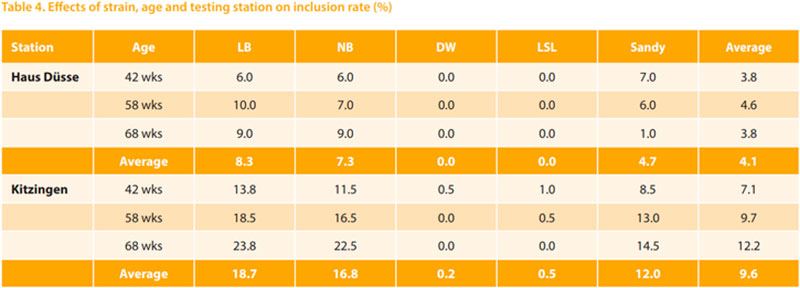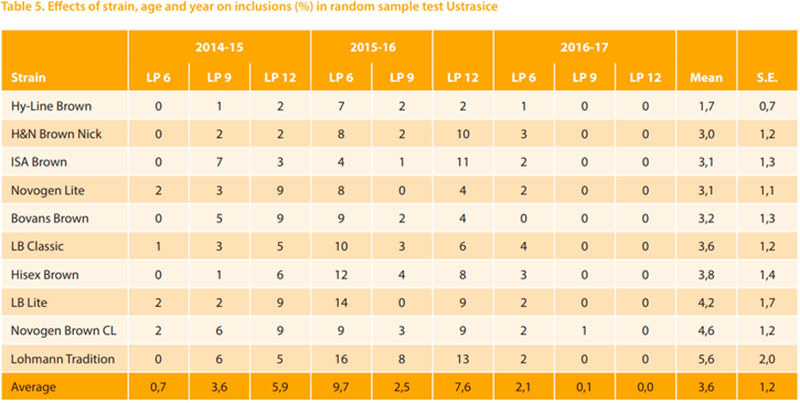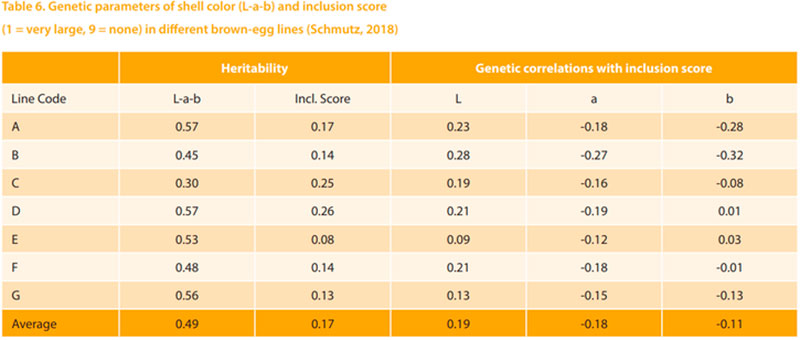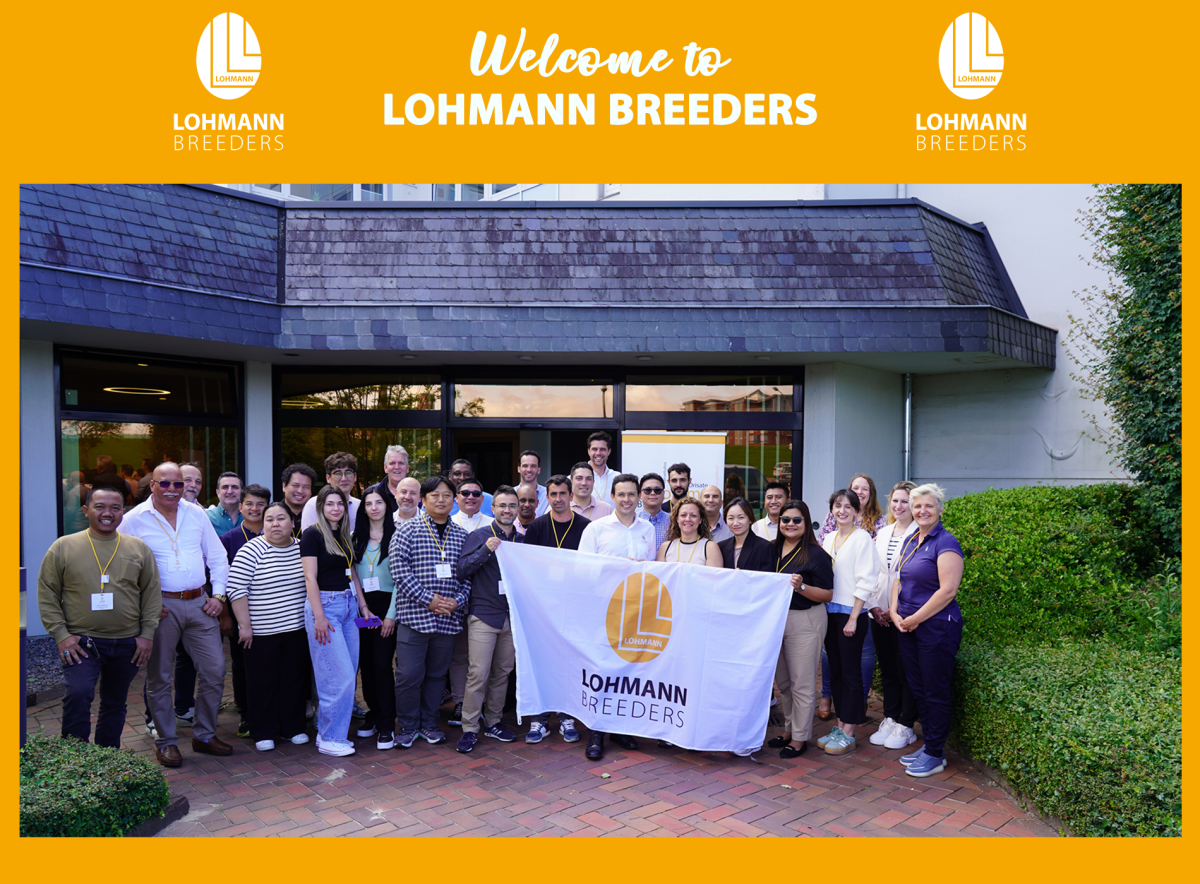Abstract
Global consumption of eggs continues to grow and is supported by a strong egg industry which combines contributions of specialists in breeding and genetics, poultry health, nutrition, farm technology, further processing and international trade to offer eggs and egg products year-round at competitive prices.
Governments in many countries support human health with regulations for the production, marketing and traceability of eggs, while primary breeders and their distributors compete in terms of product quality and technical advice for efficient production of quality eggs adapted to local preferences. The genetic potential of different strains of laying hens varies and responds to selection. Genetic differences between commercial strain crosses may seem small compared to environmental effects such as bird health, feed composition, climatic conditions and flock age.
However, the choice of the most suitable white-egg or brown-egg strain, in combination with up-to-date advice on feed composition, disease prevention and bird management, should help egg producers to maximize egg income from quality eggs adapted to regional and seasonal demand.
Governments in many countries support human health with regulations for the production, marketing and traceability of eggs, while primary breeders and their distributors compete in terms of product quality and technical advice for efficient production of quality eggs adapted to local preferences. The genetic potential of different strains of laying hens varies and responds to selection. Genetic differences between commercial strain crosses may seem small compared to environmental effects such as bird health, feed composition, climatic conditions and flock age.
However, the choice of the most suitable white-egg or brown-egg strain, in combination with up-to-date advice on feed composition, disease prevention and bird management, should help egg producers to maximize egg income from quality eggs adapted to regional and seasonal demand.
Keywords
laying hens, egg composition, internal egg quality, Haugh Units, blood spots, egg storage
Introduction
The evolution of human societies has a major effect on the co-evolution of animal and poultry farming. Senior people may remember farm life as described by Jimmy Carter (1975): “fried chicken and chicken pie were often part of our regular meals, and there were hen nests located in every convenient place…wherever the hens had an inclination to lay eggs”.Until artificial lighting programs were introduced, egg production was seasonal: most chicks hatched in spring, grew up during the summer and went into a molt before a winter pause. Following annual cycles of supply and demand, fresh eggs were scarce and expensive during winter months, and it was helpfulto know how to conserve eggs to bridge the supply gap. Nowadays fresh eggs are available year-round, and continuous utilization of farm facilities keeps the production cost low.
Researchers at agricultural colleges and research institutions in North America and Europe became interested in egg quality after the rediscovery of Mendel’s laws of inheritance and in response to commercial interest in egg production as a source of farm income.
Commercial egg producers are focused on egg income during the lifetime of a flock, and criteria of egg quality determine the sales value per egg. Geneticists collect and analyze individual data from pedigreed hens to estimate genetic parameters and calculate breeding values.
Before eggs become available in food stores, they are graded twice: (1) on the farm, eggs with obvious defects are eliminated (floor eggs in non-cage systems, dirty eggs, broken shells); (2) in packing stations, eggs are sorted on weight, checked for cracked shells and candled for inclusions. Consumers may open the egg carton before purchase to verify that all eggs have intact shells and are individually stamped with management system, country of origin and farm code.
State laboratories check farms and samples of eggs from stores to identify illegal residues in eggs, which may present temporary health risks (e.g. Fipronil found in 2017). Primary breeders compete worldwide with hybrid strain crosses primarily selected for efficient egg production and external egg quality criteria (egg size, shell strength and shell color). To benefit from the genetic potential for internal egg quality, egg producers can optimize feed composition and bird health throughout the laying cycle.
Consumers in many countries pay increasing attention to the conditions under which eggs are produced (cage, barn, free range or organic system) and accept a higher price if the eggs come from a regional producer.
For many years, the standard reference on egg quality was Romanoff and Romanoff (1949). Ternes et al. (1994) published an update in German with new references. An advertisement of Lohmann Tierzucht in this book read: “Eggs are a perfect result of evolution – we are working on further improvements”. Today’s active geneticists are still following this breeding goal in their index selection.
In recent years, several new books have been published: Nys et al. (2011) and van Immerseel et al. (2011) in France; Roberts (2017) in Australia; Simons (2017) in The Netherlands; and Kashimoro (2017) in Japan. Everybody with a responsible position in the egg industry should be aware of these books and benefit from the latest knowledge about egg quality.
The following outline will focus on genetic variation and non-genetic factors affecting internal egg quality.
Egg size and egg composition
As described more than a century ago and analyzed in more detail in recent times, eggs have three main parts: shell, yolk and albumen. Consumers may have a preference for yolk color and enjoy the taste of a soft-boiled egg or the looks of fried eggs “sunny-side up”. The yolk has more taste than the albumen, while the shell has important functions, but no nutritional value.Natural selection in different species favored eggs with optimum size for hatchability and as survival package for the developing embryo. Surprising similarities (and differences) between bird species have been reported for the percentage of yolk across a wide range of egg weight and types of birds (Table 1).
 The estimates for precocial species are of interest in the present context, because they refer to chickens before the onset of modern selection, when dual purpose breeds averaged less than 150 eggs per year. Eggs from water fowl have relatively more yolk than chicken and turkey eggs, while pigeons and other artricial species have a much lower yolk percentage. Visitors of New Zealand will learn that the state bird Kiwi lays only one extremely large egg (compared to body size) per year, with about 2/3 yolk and 1/3 albumen content.
The estimates for precocial species are of interest in the present context, because they refer to chickens before the onset of modern selection, when dual purpose breeds averaged less than 150 eggs per year. Eggs from water fowl have relatively more yolk than chicken and turkey eggs, while pigeons and other artricial species have a much lower yolk percentage. Visitors of New Zealand will learn that the state bird Kiwi lays only one extremely large egg (compared to body size) per year, with about 2/3 yolk and 1/3 albumen content.
Breeders of commercial chickens monitor the variation between and within lines for all traits which may contribute to egg income and the genetic correlation between different traits has to be known and taken into account in an optimized selection index. Well known is the negative correlation between egg number and egg size, and we could show in a designed experiment that egg size in commercial layers would drop by 0.5 g per generation if egg size were ignored (Stöve-Schimmelpfennig and Flock, 1982). Tharrington et al. (1999) compared the egg composition of a current commercial strain (H&N Nick Chick) with three Ottowa control strains and concluded that selection had produced larger eggs (63.9 vs. 58.6g) with more albumen (62.3 vs. 60.3%) and less yolk (28.5 vs. 30.6%), while overall egg quality had been maintained or improved.
Grashorn (2018) recently analyzed egg composition in a white-egg and a brown-egg strain during a full laying year (Table 2). The results show a consistent age effect in both strains (yolk percentage starts low and increases significantly until peak production). Compared to the figures published by Tharrington 20 years ago, the yolk percentage in today’s commercial layers is only slightly lower during the second half of the laying period, but significantly lower for the whole laying period. The White Leghorn strain had a small, but consistent advantage in terms of yolk and shell percentage throughout the laying period.
 The reduction of yolk percentage during recent decades can be explained as the result of selection for more efficient conversion of feed into egg mass. Some consumers may prefer small eggs from young flocks to limit their energy intake, but the egg processing industry is more interested in yolk mass than albumen. Supply and demand for liquid whole egg, yolk and albumen determines the price of each product. Currently, liquid egg yolk is being sold to bakeries in Germany at a price of 4.90 Euro/kg, compared to 1.14 Euro/kg for liquid whole egg with 23% dry matter. Processing plants in countries with a strong egg processing industry prefer contract production of white-shelled eggs from large units rather than collecting non-salable eggs at minimal price from many smaller farms. The egg processing industry also needs fresh eggs of high internal quality to separate yolks from albumen. As recently reported by Grashorn et al. (2018), even small yolk impurities in the albumen significantly reduce the foam volume, while the foam durability is impaired. Using the combined effects of genetic potential for high yolk mass and nutrition can reduce the cost of liquid yolk mass, while local energy cost and freight rates determine the chance to export dried egg products.
The reduction of yolk percentage during recent decades can be explained as the result of selection for more efficient conversion of feed into egg mass. Some consumers may prefer small eggs from young flocks to limit their energy intake, but the egg processing industry is more interested in yolk mass than albumen. Supply and demand for liquid whole egg, yolk and albumen determines the price of each product. Currently, liquid egg yolk is being sold to bakeries in Germany at a price of 4.90 Euro/kg, compared to 1.14 Euro/kg for liquid whole egg with 23% dry matter. Processing plants in countries with a strong egg processing industry prefer contract production of white-shelled eggs from large units rather than collecting non-salable eggs at minimal price from many smaller farms. The egg processing industry also needs fresh eggs of high internal quality to separate yolks from albumen. As recently reported by Grashorn et al. (2018), even small yolk impurities in the albumen significantly reduce the foam volume, while the foam durability is impaired. Using the combined effects of genetic potential for high yolk mass and nutrition can reduce the cost of liquid yolk mass, while local energy cost and freight rates determine the chance to export dried egg products.Albumen quality: Freshness, Haugh Units
Egg albumen is of special interest in terms of global nutrition, because it can be produced in all parts of the world, with less environmental impact than e.g. meat from ruminants (Flachowski et al., 2017). To assure optimal albumen quality, table eggs should be collected at least once a day, cooled down to storage temperature and stored in the refrigerator at about 4 °C. Without cooling, the albumen quality deteriorates quickly, depending on storage conditions. Recommendations for optimal storage can be found in publications by Grashorn et al. (2016) and Simons (2017).Freshness may be estimated in intact eggs by measuring the height of the air cell in candled eggs, but is more commonly reported in terms of albumen height, converted to Haugh Units. The conversion makes sense when egg quality is compared at different age of the hens. However, when primary breeders break eggs to determine internal egg quality in pedigree hens, the hens will be of similar age, and any bias in favor of larger eggs can be ignored, because it would be in a desirable direction. When measuring internal egg quality at the breeder farm, the number of eggs evaluated per hen will determine the accuracy of breeding value estimation.
Figure 1 shows the effects of storage conditions on Haugh Units.
 Genetic differences between commercial strains in Haugh Units are small, compared to differences due to age of the hens, their health status, storage temperature and egg handling from oviposition to the measurement of albumen height.
Genetic differences between commercial strains in Haugh Units are small, compared to differences due to age of the hens, their health status, storage temperature and egg handling from oviposition to the measurement of albumen height.
The results in Table 3 from two recent random sample tests in Germany (involving the same two white-egg, two brown-egg strains and one tinted-egg strain; hatched 1 June 2016, eggs analyzed at the same age) show significant differences between the two stations across all five strains and declining Haugh Units with progressing age of the hens. Effects of specific environmental conditions (cage vs. floor management) on internal egg quality should be studied in more detail in future tests.

Inclusions: Blood Spots and Meat Spots
Brown-shelled eggs sometimes includespots of variable size and color, called “blood spots” or “meat spots”. Consumers will seldom find them in white-shelled eggs, but complain if they find an unusual frequency of large inclusions in brown-shelled eggs. Genetic disposition is obviously involved, as shown again in two recent random sample tests in Germany. The results in Table 4 confirm the expected difference between brown-egg strains (LB, NB) compared to White Leghorn strains (DW, LSL), while the cross between brown-egg and white-egg parent strains (Sandy) has an intermediate frequency of blood and meat spots under the same environmental conditions. The consistent difference between stations and the apparent increase with age of the hens suggests that non-genetic effects (most likely feed composition) are important. Both German testing stations report “inclusions” of at least 3mm, without specifying the difference between blood and meat spots. The published reports contain no explanation for the obvious difference between stations, and the question remains for future tests in Kitzingen whether specific causes of increased frequency of blood or meat spots can be identified. For example, the quality and inclusion rate of critical feed components may vary between seasons and age of the hens. Another question is whether the floor management in Kitzingen causes more unrest during the time of ovulation than in the enriched cage system in Haus Düsse.
Both German testing stations report “inclusions” of at least 3mm, without specifying the difference between blood and meat spots. The published reports contain no explanation for the obvious difference between stations, and the question remains for future tests in Kitzingen whether specific causes of increased frequency of blood or meat spots can be identified. For example, the quality and inclusion rate of critical feed components may vary between seasons and age of the hens. Another question is whether the floor management in Kitzingen causes more unrest during the time of ovulation than in the enriched cage system in Haus Düsse.
Considerably lower frequencies of blood spots have been documented in random sample tests at Ustrasice in the Czech Republic, without specifying the size and differentiating between blood and meat spots. In Table 5 the frequency of blood spots in three 4-week laying periods is summarized for 10 brown-egg strains which participated in three consecutive tests. The frequency varies significantly between years and even between months of the same year, compared to rather small differences among the 10 brown-egg strains which participated in all three tests.
 Management standards for laying hens include recommendations for feed composition, which should help nutritionists to formulate balanced rations to minimize the risk of blood spots in brown-shelled eggs and to exclude critical components in case of problems. Egg producers who use superior egg quality as a marketing argument for their eggs should buy feed with assurance from the supplier that no components are used which may cause off-flavor. The smell of the feed on delivery can be used as a quality criterion, and keeping a sample of feed from each delivery for analysis in case of consumer complaints is common practice. Fishmeal of good quality has no negative effects on the taste of eggs, but rancid oil should be excluded.
Management standards for laying hens include recommendations for feed composition, which should help nutritionists to formulate balanced rations to minimize the risk of blood spots in brown-shelled eggs and to exclude critical components in case of problems. Egg producers who use superior egg quality as a marketing argument for their eggs should buy feed with assurance from the supplier that no components are used which may cause off-flavor. The smell of the feed on delivery can be used as a quality criterion, and keeping a sample of feed from each delivery for analysis in case of consumer complaints is common practice. Fishmeal of good quality has no negative effects on the taste of eggs, but rancid oil should be excluded.
Fifty years ago, when I started to work as geneticist in the H&N team, I learned a lot about egg quality from the literature and analyzed pedigree data to determine how to improve egg quality. Researchers at the University of California had used selection for high vs. low blood spot frequency in an experimental line to demonstrate how genetic theory works in practice: Starting with low frequency at the beginning of the experiment, they were able to increase the frequency significantly within a few generations (high intensity of selection for a rare trait), whereas no progress was achieved in the desired direction of fewer blood spots. When I last analyzed large volumes of pedigree records in the White Leghorn lines of Lohmann Tierzucht, the calculated “repeatability” was negative, because most hens laid all eggs without inclusions and only a few hens laid a single egg with a small blood spot.
For brown-egg breeders, it is standard practice to collect pedigree data on blood spots and to select against this undesirable trait, and we may ask why primary breeders have not been able to reduce the frequency of inclusions. It seems reasonable to suspect that shell color has something to do with the incidence of inclusions, but I am not aware of published scientific results to verify this and therefore asked for unpublished data. Table 6 shows recent estimates of genetic parameters from 7 brown-egg lines, some of which are commercially used, while others are experimental lines presently being tested for special markets. When samples of eggs are broken from pedigree hens before selection to determine internal egg quality, blood and meat spots are scored for inclusions on a scale from 1 (no spot) to 9 (large blood or meat spots), corresponding to the anticipated response of consumers if they find inclusions in eggs.
 The heritability of inclusion score is low (h² = 0.17) compared to the heritability of shell color (h² = 0.49), and all three parameters of shell color are correlated in an undesirable direction with inclusion score. Simultaneous improvement of negatively correlated traits is not impossible, but genetic progress will be slow. To assure that the incidence of inclusions will not increase and hopefully decrease, more eggs per hen would have to be scored for inclusions to increase the accuracy of breeding value estimation.
The heritability of inclusion score is low (h² = 0.17) compared to the heritability of shell color (h² = 0.49), and all three parameters of shell color are correlated in an undesirable direction with inclusion score. Simultaneous improvement of negatively correlated traits is not impossible, but genetic progress will be slow. To assure that the incidence of inclusions will not increase and hopefully decrease, more eggs per hen would have to be scored for inclusions to increase the accuracy of breeding value estimation.
Organoleptic evaluation of egg quality
My interest in the taste of eggs started in the 1970s, when I was responsible for the HNL White Leghorns breeding program of Lohmann under license from H&N. Whiteshelled eggs had dominated the German egg market for many years, while brownegg strains were gradually increasing their market share. In a market oversupplied with white eggs, affluent consumers turned to the more expensive brown eggs, assuming that these eggs taste better, because they are from happier hens, kept under natural conditions with access to free range.To test this hypothesis, we offered farm employees boiled eggs during the coffee break and asked them to score the odor and taste of the eggs. The eggs were from caged white-egg and brown-egg hens on the same feed, peeled to exclude any bias due to shell color. Instead of finding a better taste for eggs from brown-egg strains, a few eggs were noted as having a “fishy” smell, which excluded them from being tasted. We learned that people differ remarkably in their sensitivity to off-flavor, and some people even commented the “fishy taint” as “normal” in farm eggs. The same inability of some people to detect off-flavor can be observed in other situations, e.g. with rancid butter or corky wines. Some people still think that fishmeal in layer rations causes “fishy taint”, but fishmeal of good quality does not cause fishy flavor of eggs, and fishmeal has been eliminated from commercial layer feed in the EU. When rapeseed meal was identified as a possible cause of tainted eggs, nutritionists focused on the quality of the component and limited the inclusion rate in feed for brown-egg layers.
For many years brown-egg breeders had been selecting against off-flavor, without knowing whether the cause was a dominant or recessive gene. A break-through came with the introduction of molecular genetics, after researchers in Finland identified a recessive gene which blocks the metabolism of trimethylamine (Honkatukia et al. 2005, Wolc 2017). Primary breeders could then identify not only homozygous, but also heterozygous carriers and eliminate this undesirable gene from their pedigree base lines.
While the problem of “fishy taint” in eggs from commercial brown-egg layers may seem solved, feed companies must remain aware of the fact that some feed components can affect the taste of eggs, especially when used at excessive levels to reduce the feed price. Whenever possible, nutrition experiments involving critical components should include a taste panel to evaluate possible effects on internal egg quality (Damme, 2017).
Finally, it would be interesting to find out to what extent trained people are actually able to taste the effect of air quality during a major part of the day, which could then be used as a criterion to assess the birds’ wellbeing.
Changing patterns of egg consumption
Today’s commercial laying hens are bred to lay an egg almost daily throughout an extended lifecycle, while many affluent urban consumers have become “flexitarians” who may or may not include eggs in their breakfast, fast food for lunch or dinner parties. The best way to promote egg consumption is to assure consistent top quality at a fair price. Instead of unwarranted warning that eggs may cause disease problems, children should learn about food safety and hard boiled eggs from healthy flocks should be offered in schools in support of balanced nutrition, especially in developing countries.Conclusions
Worldwide egg production has increased since several decades, faster than the human population grows. While primary breeders continue to monitor all egg quality parameters which contribute to a more sustainable egg business, nutritionists need to learn more about effects of critical feed components on egg taste. Egg processors may benefit from taking known differences between strains into consideration when renewing contracts with egg producers. Consumers could benefit from information with each egg purchase, including recommendations how to maintain egg quality and prepare delicate meals from top quality eggs.
References
Carter, J. (1975) Why not the best? Why One Man Is Optimistic About America’s Third Century. Broadman Press.Damme, K. (2017) Möglichkeiten und Grenzen der Substitution von SES durch heimische Eiweißkomponenten in der Legehennenfütterung. Meeting of German WPSA in Ruthe.
Flachowsky, G., U. Meyer and K.-H. Südekum (2017) Land Use for Edible Protein of Animal Origin – A Review. Animals 7-25 (19 pp) MDPI, Basel, Switzerland.
Grashorn, M. (2018) Faustzahlen zur Eiqualität. In: Geflügeljahrbuch 2018. Verlag Eugen Ulmer, Stuttgart, Germany.
Grashorn, M.A., F. Hüeber and N. Kretzschmar (2018) Effect of yolk on functional properties of chicken eggs. Proc. XVth European Poultry Conference, Dubrovnik.
Grashorn, M, J. Juergens and W. Bessei (2016) Effects of storage conditions on egg quality. Lohmann Information 50(1): 22-27.
Honkatukia, M., K. Reese, R. Preisinger, M. Tuiskula-Haavisto, S. Weigend, J. Roito, A. Mäki-Tanila and J. Vilkki (2005) Fishy taint in chicken eggs is associated with a substitution within a conserved motif of the FMO3 gene. Genomics 86, 225-232.
Kashimori, Ayuko (2017) The Illustrated Egg Handbook. Context Products Ltd.
Nys, Y., M. Bain and F. van Immerseel (2011) Improving the safety and quality of eggs and egg products. Vol. 1: Egg chemistry, products and consumption. Woodhead Publishing Ltd.
Roberts, J. (2017) Achieving sustainable production of eggs. Vol. I: Safety and quality. Burleigh Dodds Science Publishing.
Romanoff, A.L. and A.J. Romanoff (1949) The Avian Egg. John Wiley & Sons, New York.
Simons, P.C.M. (2017) Egg Signals. A practical guide to improving egg quality. Roodbont Publishers B.V.
Sotherland, P.R. and H. Rahn (1987) On the composition of bird eggs. The Condor 89: 48-65.
Stöve-Schimmelpfennig, K. and D.K. Flock (1982) Eigewicht und relative Fitness in der Legehennenzüchtung. Archiv für Geflügelkunde 46: 270 – 275.
Ternes, W., L. Acker, und S. Scholtyssek (1994) Ei und Eiprodukte. Grundlagen und Fortschritte der Lebensmitteluntersuchung und Lebensmitteltechnologie. Band 22. Paul Parey.
Tharrington, J.B., P.A. Curtis, F.T. Jones and K.E. Anderson (1999) Comparison of physical quality, composition and nutritional characteristics of eggs from historic strains of Single Comb White Leghorn chickens. Poultry Sci. 78: 591-594.
Van Immerseel, F, Y. Nys and M. Bain (2011) Improving the safety and quality of eggs and egg products. Vol. 2: Egg safety and nutritional value. Woodhead Publ. Ltd.
Wolc, Anna (2017) Molecular breeding techniques to improve egg quality. Chapter 17 in: Roberts (Ed.) Achieving sustainable production of eggs.







